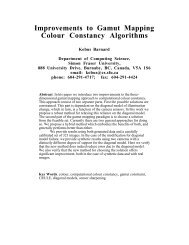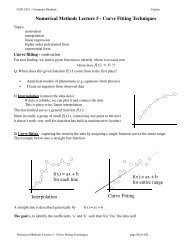2 1. INTRODUCTIONFigure 1.1Examples of hand-written digitstaken from US zip codes.tackled using handcrafted rules or heuristics for distinguishing the digits based onthe shapes of the strokes, but in practice such an approach leads to a proliferation ofrules and of exceptions to the rules and so on, and invariably gives poor results.Far better results can be obtained by adopting a machine learning approach inwhich a large set of N digits {x 1 ,...,x N } called a training set is used to tune theparameters of an adaptive model. The categories of the digits in the training setare known in advance, typically by inspecting them individually and hand-labellingthem. We can express the category of a digit using target vector t, which representsthe identity of the corresponding digit. Suitable techniques for representing categoriesin terms of vectors will be discussed later. Note that there is one such targetvector t for each digit image x.The result of running the machine learning algorithm can be expressed as afunction y(x) which takes a new digit image x as input and that generates an outputvector y, encoded in the same way as the target vectors. The precise form of thefunction y(x) is determined during the training phase, also known as the learningphase, on the basis of the training data. Once the model is trained it can then determinethe identity of new digit images, which are said to comprise a test set. Theability to categorize correctly new examples that differ from those used for trainingis known as generalization. In practical applications, the variability of the inputvectors will be such that the training data can comprise only a tiny fraction of allpossible input vectors, and so generalization is a central goal in pattern recognition.For most practical applications, the original input variables are typically preprocessedto transform them into some new space of variables where, it is hoped, thepattern recognition problem will be easier to solve. For instance, in the digit recognitionproblem, the images of the digits are typically translated and scaled so that eachdigit is contained within a box of a fixed size. This greatly reduces the variabilitywithin each digit class, because the location and scale of all the digits are now thesame, which makes it much easier for a subsequent pattern recognition algorithmto distinguish between the different classes. This pre-processing stage is sometimesalso called feature extraction. Note that new test data must be pre-processed usingthe same steps as the training data.Pre-processing might also be performed in order to speed up computation. Forexample, if the goal is real-time face detection in a high-resolution video stream,the computer must handle huge numbers of pixels per second, and presenting thesedirectly to a complex pattern recognition algorithm may be computationally infeasible.Instead, the aim is to find useful features that are fast to compute, and yet that
1. INTRODUCTION 3also preserve useful discriminatory information enabling faces to be distinguishedfrom non-faces. These features are then used as the inputs to the pattern recognitionalgorithm. For instance, the average value of the image intensity over a rectangularsubregion can be evaluated extremely efficiently (Viola and Jones, 2004), and a set ofsuch features can prove very effective in fast face detection. Because the number ofsuch features is smaller than the number of pixels, this kind of pre-processing representsa form of dimensionality reduction. Care must be taken during pre-processingbecause often information is discarded, and if this information is important to thesolution of the problem then the overall accuracy of the system can suffer.Applications in which the training data comprises examples of the input vectorsalong with their corresponding target vectors are known as supervised learning problems.Cases such as the digit recognition example, in which the aim is to assign eachinput vector to one of a finite number of discrete categories, are called classificationproblems. If the desired output consists of one or more continuous variables, thenthe task is called regression. An example of a regression problem would be the predictionof the yield in a chemical manufacturing process in which the inputs consistof the concentrations of reactants, the temperature, and the pressure.In other pattern recognition problems, the training data consists of a set of inputvectors x without any corresponding target values. The goal in such unsupervisedlearning problems may be to discover groups of similar examples within the data,where it is called clustering, or to determine the distribution of data within the inputspace, known as density estimation, or to project the data from a high-dimensionalspace down to two or three dimensions for the purpose of visualization.Finally, the technique of reinforcement learning (Sutton and Barto, 1998) is concernedwith the problem of finding suitable actions to take in a given situation inorder to maximize a reward. Here the learning algorithm is not given examples ofoptimal outputs, in contrast to supervised learning, but must instead discover themby a process of trial and error. Typically there is a sequence of states and actions inwhich the learning algorithm is interacting with its environment. In many cases, thecurrent action not only affects the immediate reward but also has an impact on the rewardat all subsequent time steps. For example, by using appropriate reinforcementlearning techniques a neural network can learn to play the game of backgammon to ahigh standard (Tesauro, 1994). Here the network must learn to take a board positionas input, along with the result of a dice throw, and produce a strong move as theoutput. This is done by having the network play against a copy of itself for perhaps amillion games. A major challenge is that a game of backgammon can involve dozensof moves, and yet it is only at the end of the game that the reward, in the form ofvictory, is achieved. The reward must then be attributed appropriately to all of themoves that led to it, even though some moves will have been good ones and othersless so. This is an example of a credit assignment problem. A general feature of reinforcementlearning is the trade-off between exploration, in which the system triesout new kinds of actions to see how effective they are, and exploitation, in whichthe system makes use of actions that are known to yield a high reward. Too stronga focus on either exploration or exploitation will yield poor results. Reinforcementlearning continues to be an active area of machine learning research. However, a





